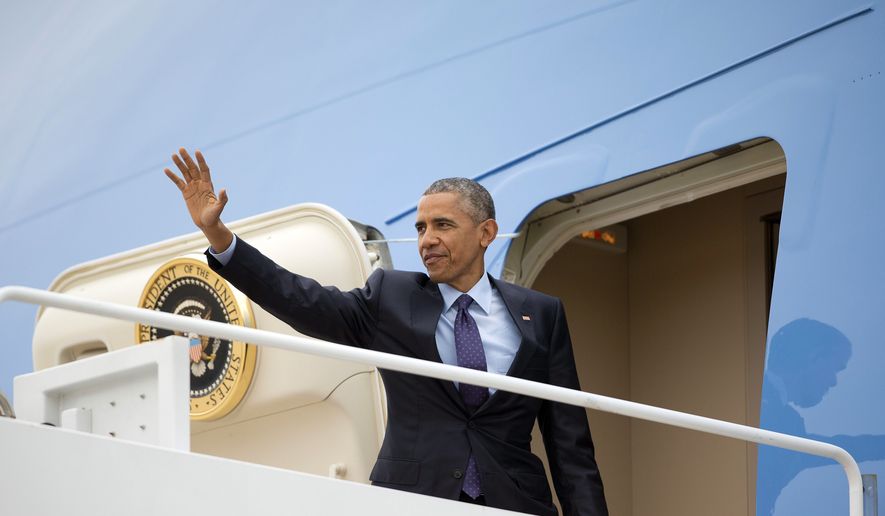Nearly a year after the flood of unaccompanied children streaming across the U.S. border reached crisis proportions, President Obama this week heads to a key summit in Panama amid concerns the administration hasn’t done enough to address the root causes of the problem.
On Friday, Mr. Obama will attend the Summit of the Americas, a gathering which will include the leaders of Honduras, Guatemala and other Central American nations that have seen tens of thousands of their children make a dangerous trek through Mexico in the hopes of reaching safety in the U.S.
The stream of children, while on track to be lower than last year, still represents a serious challenge to U.S. border enforcement efforts, and Homeland Security Secretary Jeh Johnson recently warned lawmakers that crossings could rise in the spring and summer months.
From the beginning of the fiscal year on Oct. 1 through March 31, 15,374 children have been apprehended trying to cross the U.S.-Mexico border. During the same 6-month period, 13,461 “family units” — mostly mothers traveling with their children — have been caught. The figures include children and families from Honduras, Guatemala, El Salvador and Mexico.
Those numbers are lower than the unprecedented levels seen last summer. Last June, for example, 10,620 children were apprehended, the largest monthly figure to date.
Mr. Johnson told Congress last month this year’s numbers are roughly 40 percent lower than last year’s.
SEE ALSO: Illegal immigrant children surge across border at highest rate since last summer’s peak
“I hope it stays that way, but we have to be prepared in the event it doesn’t,” he said.
But analysts say the administration, despite dedicating hundreds of millions of dollars to the problem and pressing Congress for another $1 billion to help Central American economies, merely is addressing the symptoms, not the causes.
“An evaluation of the 2014 policies finds that they focused primarily on short-term enforcement concerns, particularly at U.S. borders and along transit routes. The lack of a longer-term vision and broader geographical focus may limit the policy’s success,” reads a recent report by the Migration Policy Institute.
At the height of last summer’s crisis, the administration announced it would send more agents to patrol the Southern border and also would beef up the number of judges hearing immigration cases, a move meant to expedite the process by which children and families are either granted asylum or returned to their home countries.
The White House also announced it would spend hundreds of millions of dollars to stem the flow of minors. It included, for example, a $40 million campaign to fight gang recruitment of children and teenagers in Guatemala.
The Department of Homeland Security has been running print, radio and TV ads in Central American countries discouraging parents from sending their children to the U.S.
SEE ALSO: Immigration activists disillusioned with Obama, Democrats as amnesty afterglow fades
Mr. Obama, Vice President Joseph R. Biden and other officials also routinely have spoken out and encouraged their counterparts in Central America to take more action.
Mr. Obama also is pushing Congress to give him another $1 billion to help aid struggling Central American economies, though it’s unlikely the GOP-controlled House and Senate will fully comply with his request.
Still, some specialists say the administration indirectly contributed to the crisis by creating confusion in Central American countries. Mr. Obama’s 2012 executive action allowing young illegal immigrants to remain in the U.S. free from the threat of deportation likely was misinterpreted by some Central American parents as a green light to send their children to America, according to Juan Carlos Hidalgo, a policy analyst on Latin America at the Cato Institute’s Center for Global Liberty and Prosperity. “I think [last summer’s] particular episode had to do with misinformation and the false premises many people were under — that they could send their children here,” he said.
Mr. Hidalgo added that the administration’s current efforts, including the push for more money, merely are meant to allow the president to tell Central American leaders he’s taking action.
“The easier way for the administration is to throw money at the problem. That’s what the Obama administration is doing,” he said. “A $1 billion program — we will give them money to encourage them to reform … and then you look at to the cameras and say, ’We did something.’ I don’t think it’s going to work.”
• Ben Wolfgang can be reached at bwolfgang@washingtontimes.com.




Please read our comment policy before commenting.